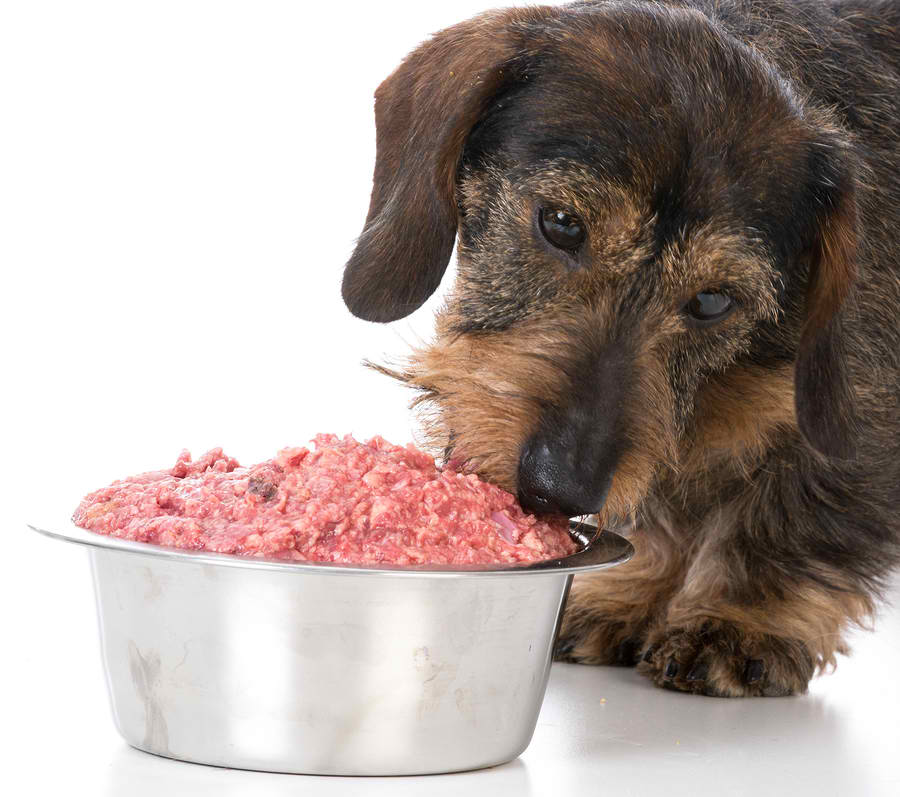
This post may contain affiliate links. We are compensated for referring customers to our affiliate partners.
Dog food trends come and go. So it is really important to understand which trends will improve your dog’s diet and which are just a fad. Raw dog food diets are an emerging trend that may provided a lot of benefits to your dog.
However since they are a newer diet trend, it’s important to really understand the risks involved in making such a dramatic dietary change.
We have put together a list of some of the biggest safety concerns with a raw food diet and how to mitigate those risks so you can try a raw food diet without risking your dog’s health.
Why Raw Dog Food?
First, we need to understand the idea behind the trend of introducing your dog to a raw food diet. Raw food diets for dogs have actually been around for a long time. Before the modern manufacturing of dog foods a little more than 100 years ago, people fed their dogs a raw food diet. Raw food diets are also often fed to racing and working dogs and they are common outside of America. The thinking behind a raw foods diet is that they are more natural than processed dog food and thus, may be much healthier.
What Is A Raw Food Diet For Dogs?
A raw foods diet is made up of foods that have not been processed. These foods include raw meat, fish, and poultry. Organ meats and bones are often served. Raw food diets also typically include raw eggs and dairy, as well as a variety of raw fruits and vegetables. Some raw foods diets contain rice and other whole grains. Raw foods are fed directly to your dog in place of kibble or canned dog food.
The Benefits
There are many possible benefits to a raw foods diet. Since the foods are unprocessed they maintain a high nutritional value. A high nutritional balance brings a variety of benefits like increased energy, stronger bones and teeth, and better digestion. Also the higher nutritional value can reduce the risk of chronic illnesses like cancer and diabetes.
The Risks
There are three main risks associated with a raw foods diet so switching to a raw foods diet is not always the best plan for your dog. However, if you decide you want to try a raw food diet you need to know these risks and how to mitigate them so ensure the health and safety of your dog. Also as with any dietary changes, you should consult your veterinarian first.
Risk 1: Food Contamination
Raw foods are consumed completely unprocessed. However, processing foods reduces bacterial contamination. Foods especially like poultry, meat, and fish can be dangerous if consumed raw by anyone, including your dog. There is a big risk of food poisoning from salmonella and E. Coli. So if you decide to feed your dog raw food, you need to be careful the sourcing and handling of the food. You need to make sure you get your food, especially your meat from trustworthy sources so that the risk of bacterial exposure is reduced. You also want to make sure you don’t cross contaminate your food. When handling raw food always wash your surfaces and your hands thoroughly. If you take the necessary steps to reduce bacterial exposure, you can reduce this risk.
Risk 2: Inadequate Nutrition
A raw foods diet can cause a nutritional imbalance if not executed properly. If you are just feeding your dog whatever raw food you have around the house, they may not be getting all the nutrition they need. This is especially important when it comes to calcium, vitamin B, and phosphorous. Without these crucial nutrients your dog can suffer some serious health effects. The best way to ensure that your dog is getting adequate nutrition from their raw foods diet is to have a plan. Make sure that you consult with your vet to put together a diet complete with all the vitamins, minerals, and nutrients your dog needs. If you stick to this diet, your dog will get all the nutrients it needs to really benefit from a raw foods diet.
Risk 3: Not Right For Every Dog
A raw foods diet can have some great benefits for your dog. However, like all diets, it is not one size fits all. If your dog is already experiencing an illness, a raw foods diet may exasperate the symptoms. Raw foods diets contain a lot of fat so they are not great for dogs that are having liver or gall bladder issues. Raw foods may also be hard for your dog to digest, so it is not a good diet for dogs with sensitive stomachs. Finally, it may not be great in the early stages of your dog’s life. Puppies especially need a well-rounded nutritional profile to make sure they develop correctly. So check with your veterinarian before you implement a raw foods diet. Also if you are switching to a raw foods diet, watch your dog, make sure that you are seeing all the benefits you expect. If not, then the diet may not be right for them.
Implementing A Raw Foods Diet
Ultimately if you decide that you want to try a raw foods diet, you need to be very careful how you introduce the diet to your dog. Like with all dietary changes, a slow transition is best so your dog gets used to the new food. Also since raw foods diets include foods your dog has never had before, introduce these foods in small quantities and see how your dog reacts to them. You also need to be very careful introducing bones into your dog’s diet because they can cause them to choke or cut the throat and stomach of your dog. A slow introduction is the best way to protect your dog from the risks of a raw foods diet.
